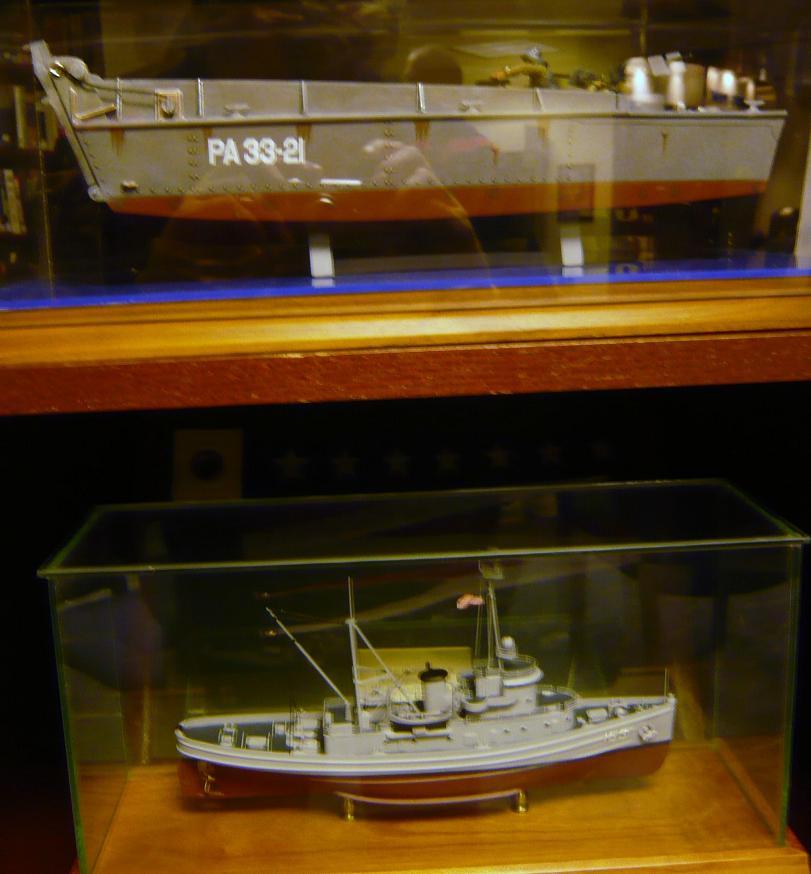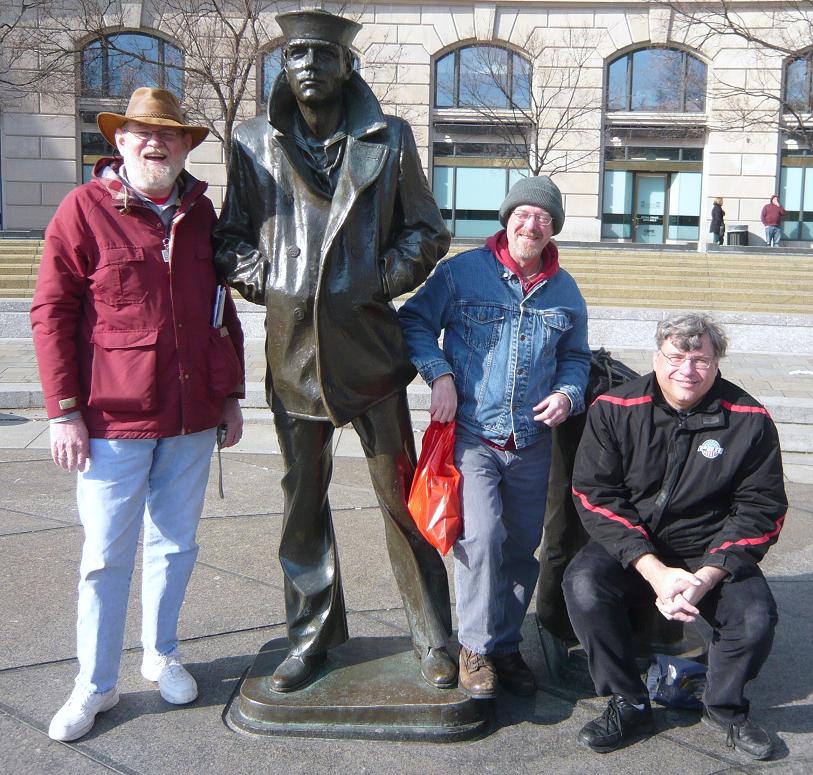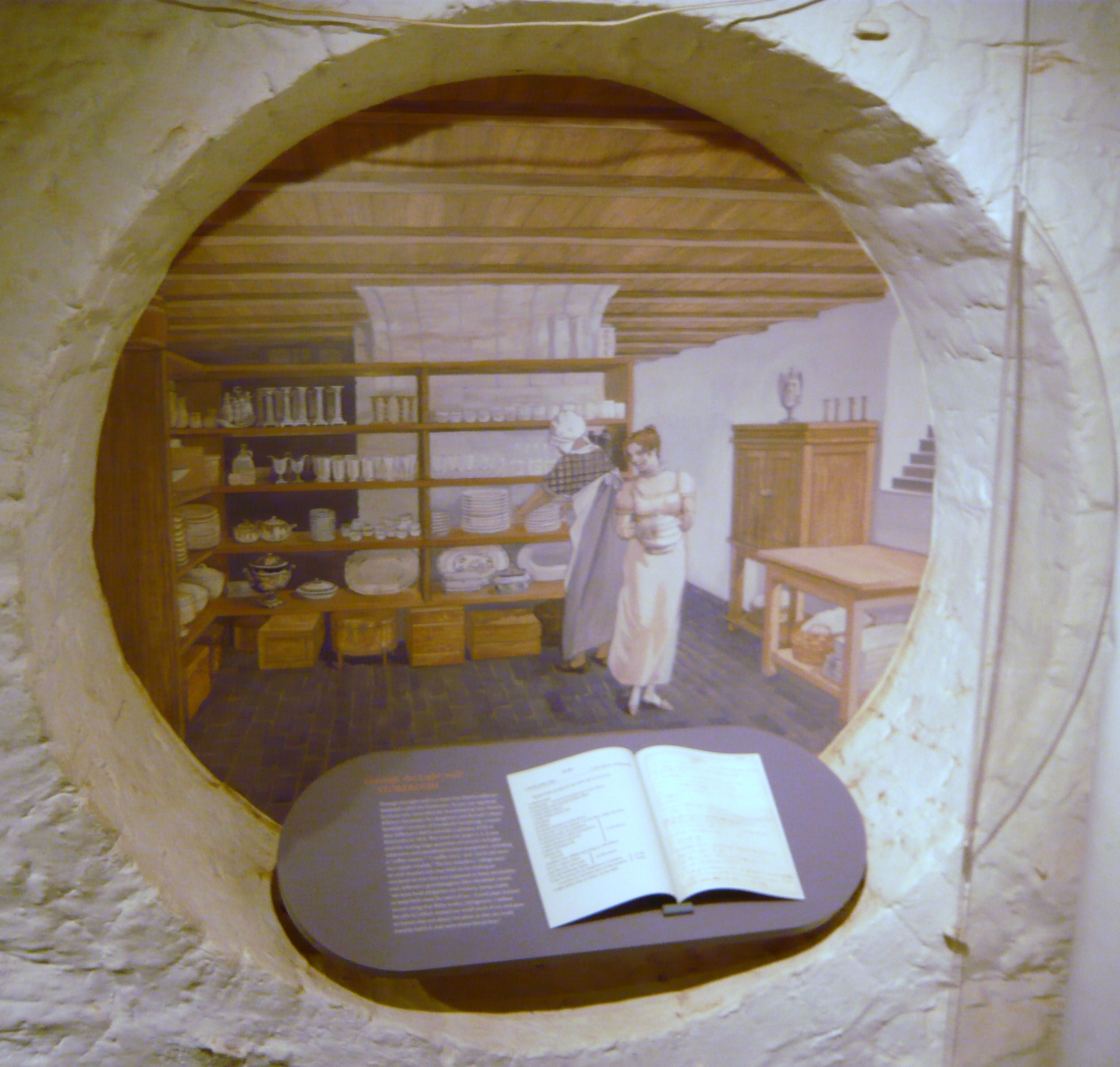On leaving Fairbanks, we gave some consideration to traveling north up the Dalton Highway towards the Arctic Circle or even as far as the Arctic Ocean but it came down to making a choice between either of those and having to cut out a day or even two to somewhere else as we had reservations on the weekly ferry ride from Haines in about a week. The side trip just wasn’t worth it so we headed to our next planned destination, Denali National Park.
Denali National Park and Preserve dates back to 1917 when Congress approved the creation of McKinley National Park. While its most famous feature is the tallest mountain in the US, the park and preserve includes 6 million acres of wild country with a single ribbon of road through it. But first we have to get there!

The ride from Fairbanks to Denali started out alternating between relatively flat with mountains in the distance or else riding along higher up with the scenery falling away to either side of the road. We crossed over the Nenana River where there was an old tug boat pulled up along the shore which had pulled freight up and down the river.
Eventually the road begins the dip into a canyon following the course of the Nenana Creek. We encountered more construction both for roads and bridges. The road construction had a pilot car for a length of unpaved road but the short bridges were controlled by a flagman or a portable traffic light.

The skies were partly cloudy which resulted in light patterns on the landscape for additional texture.

Just before we got to the road into Denali, there was a village of hotels, cabins, resorts, stores, and outfitters catering to the tourist trade. They all looked to be doing a good business this day.
Charles Sheldon, a gentleman hunter from Vermont and others lobbied Congress for nearly a decade before persuading them to create Mt. McKinley National Park in 1917. In 1921, Harry Karstens, an outdoorsman and dog musher was hired as the first park superintendent. Gold miners and others in Fairbanks and nearby called the icy granite mountain Mt. McKinley. Sheldon referred to it as “the mountain” or Denali, the Athabascan name meaning the high one. Mt. McKinley is now officially 20,237 feet above sea level, the highest in North America. This figure is 83 feet shorter than the 1952 number (which would have been when my folks were in the area.) There is this interesting article on Discovery.com which talks about why the differences.
Along with the wild landscape there were also animals in the area that were to be protected. Specifically, the Dall sheep in the area were being aggressively killed by market hunters. Per the stories we were told there, the market hunters would kill the sheep they needed to market and would also kill the other sheep around and leave them to rot to limit their competitors ability to provide meat. The National Park and Preserve designation was a small step in providing some control over that situation.
Arriving at the park entrance, the roadway goes to the campgrounds and also to the visitors center. From the visitors center, there are options for interior transportation. There are guided tour buses which travel into the interior of the park and various shuttles to different points within the park.

We went directly to the visitors center. This is the spot to get acclimated and find out about the various accommodations for getting around. The visitors center also has a small cafeteria and a gift shop. The 85 mile road through the park has access limited to the tour buses and the campers’ shuttles. There are also flight-seeing tours from nearby Talkeetna that take you around, some even land to let you walk around.
We chose to take the short shuttle to the Sled Dog Kennels. The dogs are working animals at the park providing access to remote areas and support for working and research parties even during the winter months. More about the kennels here.
The bus (similar to school buses) takes you on the 10 minute ride (or it could be except for the stops for road construction) to the kennels. During the summer months, rangers and the dogs demonstrate a working team. Before the demonstrations in the summer, you get a chance to visit with and pet the dogs. Visits and petting are opportunities year round but the demonstrations are summer months only.

We were surprised to learn that the dogs are controlled by voice command only. For some reason, we had always thought there were reins or similar like larger draft animals.
Each position in the dog team has a specific purpose and different dogs are better suited for each position. Nearest the sled is the wheel dog. The wheel dogs are the strongest and provide momentum to get the sled up on the surface and moving (like getting a boat up on plane).

In front of the wheel dog is the swing dog. The swing dog provides power but is also trained to swing out on a turn, rather than follow directly in the tracks of the lead dog. The lead dog responds to voice control to turn, go or stop. The dog team may include up to 12 dogs depending on the load and course to be run.
The dogs typically have a 9 year life on the sleds with an average 14 year life span. That link above even talks about adopting retired dogs.

As an aside, we saw the tourist couple we met at LARS in Fairbanks and said hello.
We rode back to the visitors center and decided to take one of the shuttle buses for a brief ride around to the campgrounds. It became more clear that many of the tourists in the park are camping or hiking parts of the large park. While on the shuttle, we stopped at the train crossing to let the Alaska Railroad Denali route train go by. Many tourists will board the train for the ride between Anchorage and Denali with a stop in Talkeetna for more of the beautiful scenery.

We didn’t really appreciate just how big the park and preserve are. We were unable to see Mt. McKinley from the visitors’ center. We were actually surprised that we asked several of the non-NPS workers which direction the Mountain was and they didn’t know. We’ve since learned Mt. McKinley is about 80 miles southwest from the visitors’ center.
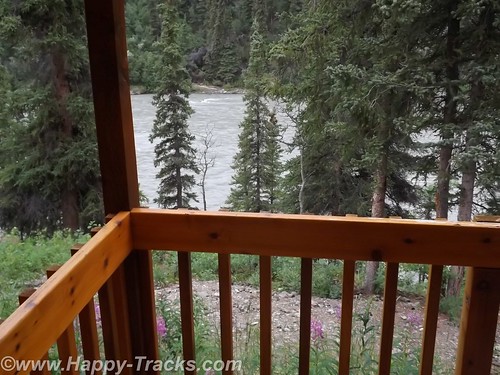


After several hours at the park, we headed out for our accommodations which had been recommended by a fellow on ExpeditionPortal forums. Healy Denali Grizzly Bear Cedar Lodge is just a few miles south of the park entrance (although our GPS directions sent us north instead). The Grizzly Bear Cedar Lodge is away from the cluster of hotels in the village outside the gate and has RV sites, a small general store, a laundromat and a gift shop. The Cedar Lodge itself is set on the banks of the Nenana River. Its not as expensive as the village but doesn’t have all the shops and entertainment within walking distance.
We did get a recommendation for the restaurant just a bit further south, 229 Parks. The food was a more local produce with many non-fried food choices. We had the salmon and the crabcakes and would recommend both the restaurant and lodge to visitors to the area provided you have transportation with you.

The next morning, we headed south towards Anchorage. We still hadn’t seen Mt. McKinley but there were supposed to be several points along the road where we could see it, weather permitting. As we drove along, we saw fog and clouds where Mt. McKinley should be but we never saw the place where we could get out weather permits and thus left Alaska without seeing the Mountain.
You can see all of the pictures and 2 more short videos from this leg of the trip here.
We invite you to continue along with us and hope you enjoy the account!
Tag Archives: travel
Summer 2014: Alaska via the AlCan, Fairbanks
Continuing north from Delta Junction toward Fairbanks, we crossed the Tanana River and got our first glimpse of the Alaskan Oil Pipeline where it crossed the river near the road.

The pipeline is 48 inches in diameter, 800 miles long and crosses three mountain ranges and over 500 rivers and streams.
Most of the major river crossings for the pipeline have the pipeline buried under the river bottom but the power of the current and the silt here create major scouring of the river bottom. The scouring could eventually expose the buried pipeline and lead to damage. The pipeline is built to withstand an earthquake up to 7.5 and cold down to 60 below. The pipeline includes zigzags in its course to allow for some shock absorption as well as thermal expansion. The supports are built to transfer heat away and thus prevent melting of the frozen ground beneath the towers.

The bridge over the Tanana is the second longest along the pipeline at 1200 feet. This crossing over the Tanana River is the first place you see the pipeline in the ride up the AlCan towards Fairbanks.
Special consideration was given to the wildlife along the pipeline’s course to minimize the impact of the pipeline. Those considerations include the tower designs as well as lengths where the pipeline remains below ground to allow for uninterrupted crossings by the wildlife.

The scenery heading into Fairbanks includes mountains in the distance but more consistent snow cover than we’d seen earlier. Our first stop in Fairbanks was another viewing point of the pipeline with an informational display. You can also see where the pipeline goes underground here.

They regularly measure the flow through the pipeline to determine ways they can improve efficiency. One of the steps they employ is to periodically clean the pipes of accumulated sludge using a pipeline inspection gauges or “pig”. A pig is essentially a phenolic plug that travels along and cleans the insides of the pipe.


Fairbanks grew out of a trading post on the Chena River established around 1901 with the landing of the river boat Lavalle Young. The discovery of gold in the hills north of town in 1902 assured its success. By 1907, railroads had largely replaced the riverboats.

We went into Fairbanks itself with the first stop at the Visitors Center on the banks of the Chena River. On the grounds there is an original cabin from early Fairbanks (pre-1910), still in its original location. The cabin is small, in part to minimize the heating needs while still providing adequate living space for a kitchen, sitting area and sleeping space. It is worth noting that by 1910, Fairbanks had limited electric and telephone service in place.

In downtown Fairbanks, there is another marker for the Alaska Highway at 1523 miles. Since much of the military traffic on the highway during WWII was destined for the military bases there, some measure the highway from Dawson Creek to Fairbanks.



Several historic buildings remain in downtown, including the Oddfellows Hall, formerly a bath house and health clinic and the Masonic Lodge nearby. Located in the old Oddfellows Hall building is the Alaska Mining Hall of Fame Foundation museum. Admission is by donation. The museum is still getting itself organized but holds memorabilia of the mining industry including some very clear explanations of the different methods of mining used. There is also a gift shop and display devoted to the Iditarod dog sled race.

We checked into our motel and grabbed dinner at the Denny’s located next door. This particular Denny’s has the distinction of being the northernmost Denny’s in the world!
The University of Alaska Fairbanks (UAF) campus was near our lodgings. Just a couple of miles further down the road is the Large Animal Research Station (LARS) specializing in high latitude biology, particularly muskox and caribou. LARS is open for tours and we availed ourselves.

The LARS tours are run by University personnel who are specialists in the animals. They also have a small gift shop, a picnic area and some vintage farm equipment. We watched a family whose children were absolutely fascinated with the antler collection and the old tractors while we waited for our tour to begin.

The day we were there, they also had mosquitoes. Betty has always been something of a magnet for mosquitoes which has detracted from the enjoyment of many outside activities. Today we tried the Off! Clip-on Fan and it worked. While we stood talking to another couple who were also touring (they were in a big 5th wheel camper), you could see the difference in the swatting. It was noticeable enough the lady asked what Betty was using. The Off! fan is available in a drug and discount stores including Home Depot and we recommend it! They last about 12 hours of use but seal when you turn them off so you can use it for up to two weeks after initially opening the refill.

Muskox have horns that loop down similar to a water buffalo although not as long. Muskox also have wool which they shed (no need for shearing) that is among the softest stuff in the world. A hat or scarf made of quivit will make cashmere seem coarse. Unlike many wools, quivit does not shrink. We would visit a shop in Anchorage where handmade items were available for shopping.


Muskox have very thick skulls and generally will defend their territory or herd by butting heads. LARS has a gate that shows just how much force is available through that thick skull. In the wild, muskox will defend the herd by backing into a circle, heads out, with the youngsters in the circle. A tightly packed circle of muskox is a formidable force.

LARS also has caribou which are very similar to reindeer. In fact, according to the guide, the principle difference in a caribou and a reindeer is that reindeer are domesticated. She actually raised the question whether their caribou still qualified since they were penned.
We also learned the difference in horns and antlers (which you may have already known). Antlers grow each year and are shed while horns are permanent.
The farm is staffed year round to care for the animals and the property. On site, there are several buildings ranging from the old barn to a modern quarters for the caretakers.


Next we went to visit the main campus of UAF and the Museum of the North. The exterior of the building resembles the overlapping plates of the ground. It shares some similarity to the iconic shape of the Sidney Opera House.
The Museum displays are divided geographically and to coincide with the four main groups of Native Alaskans. As we walked into the main exhibit room, we saw the only grizzly (brown) bear we would see on the trip.

There were exhibits of archaeological significance like the fossilized mammoth and of cultural significance like the totems and clothing. There were also exhibits of the historical events such as the gold rush and the oil exploration.

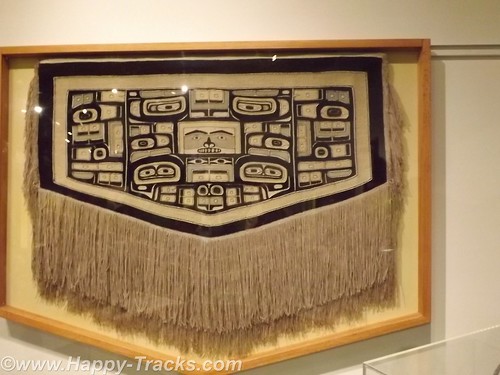



There was also an exhibit dedicated to the Japanese occupation of the Aleutians during WWII and the relocation/interment of those persons of Japanese ancestry during that period.
The museum had a gift shop with a wide array of items from kids plastic toys to hand-crafted display items. As befitting a museum, it included books and some household and kitchen goods with thematic decorations.
On the grounds, was the restoration of the Russian blockhouse which dates back to the Russian ownership of the territory. The blockhouse was part of the fort when the Russians were primarily trapping for pelts.

One other item we noticed was the electrical outlets in the parking area. I suppose when the winter temperatures plummet, plugging your car’s block or battery heaters may be the only hope you have of restarting the car for the trip home.
We headed back to the hotel for the night. The next morning we shared a conversation with one of the many motorcyclists we had encountered on our trip. This particular gentleman (around our age) was hanging around the hotel because he had fallen off his bike and had a spine compression injury which left him feeling unsafe and uncomfortable making the trip home on his bike. He had checked into the costs of shipping his bike back to Seattle and it was to be about $500. One of the others in his group had suffered some sort of cardiovascular attack and he was waiting to find his prognosis and plans. Perhaps they could share the cost of the freight back home.
You can see all of the pictures from this leg of the trip here.
We invite you to continue along with us and hope you enjoy the account!
Summer 2014: Alaska via the AlCan
After breakfast, we visited the tourist center in Dawson Creek in the Northern Alberta Railway museum which is part of the old train station. In addition to the usual fare of souvenirs, brochures and information, of particular value was a listing of the various facilities along the Alaska Highway showing lodging, restaurants and fuel locations all on one sheet of paper.
We used an annual publication called the Milepost. This guide has been published annually since 1949 and is considered the definitive guide to the AlCan. The guide, in addition to advertising content, contains a milepost by milepost guide book for the major highways throughout this part of Canada and for Alaska. Its layout is logical but is sometimes difficult to follow along as you are sometimes required to read from bottom to top to match your travels. The single page sheet from the visitor center at Dawson Creek allowed a quick glance to determine the information that the Milepost would provide over several pages, once you found them.
We had noticed signs outside this and other buildings that indicated “Muster Area” and asked what that meant. Unlike most places in the States, its fairly common in Canada to identify a spot for building occupants to muster (meet) in the event they have been evacuated from the building. I remember our work offices had designated places for the workers to meet in case of evacuation but it was a place you were supposed to know rather than being marked. The designated area seems like it could be useful in quickly determining whether everyone had made it safely out.
We were finally on our way on the Alaska Highway.
About 20 miles on, we found a marked section of the old highway. We turned to go that way and it was a bit more rustic. 
It happened this section included the old Kiskatinaw Curved Bridge. The original bridge was built of wooden timber and this was the last timber bridge still in use on the old highway. It also is unusual in that it is curved about 9* in its 540 ft. length. Because of its timber construction it is limited in capacity to 25 tons which meant that heavy trucks were forced to ford the river rather than cross the bridge.

With the expanding oil and gas industry, this became more of an issue and a re-routed road and new bridge were built in 1978.
Further along we crossed the Peace River Bridge which is the longest water span on the Alaska Highway. It opened in 1958 and replaces the Peace River Suspension Bridge which collapsed dramatically in 1957. If you want to more about the collapse, see here. The “new” bridge is metal-decked.
In general, the road is in good repair but there are sections where that is not the case. Summer is also construction season. Any significant repairs are done during the summer rather than during the cold season when frozen ground and frigid air temperatures prevent effective repairs.

We had lunch at the Pink Inn which has been there for the last 50 years. It is open 24 hours a day and includes fuel, lodging and a restaurant. The restaurant has a cook on duty through the evening meal. After that, there are sandwiches and some serve yourself type foods through the night. Most of the menu was burgers and steaks type meals. We discovered that menus outside the cities tended towards hearty meals and large portions. This meets the tastes of most of the clientele — truck drivers, workers in the oil and gas industry or lumbering. It also offsets the relatively high prices which comes, in part, from the high transportation costs.

Shortly after the lunch, we saw our first black bear alongside the road.
Further along, we stopped to allow clearing of some fallen rocks.

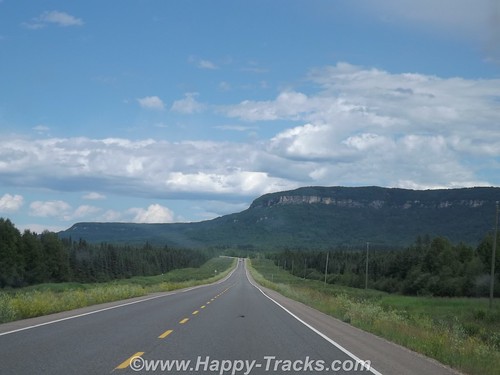

We passed by a natural gas processing facility. As part of the natural gas production, sulfur is removed and recovered. This processing plant pipes the sulfur across the road but due to the harsh environment and constant movement of the ground in a freeze/thaw cycle the sulfur pipe runs above the road.
The wild countryside just rolled off mile after mile of gorgeous scenery in the form of forests and mountaintop.

We saw a young elk on the roadway which stayed around for several pictures but he wasn’t looking his best for his photographic debut as his coat was moulting.
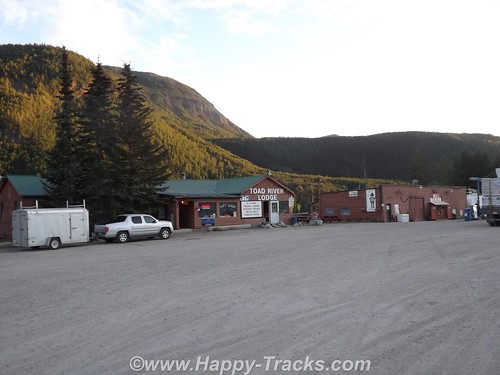
Our first overnight stay was at the Toad River Lodge at MP 422. We had “only” traveled 405 miles today along the highway but the historic mileposts are still used even though rerouting has shaved some miles off the route. Like most of these roadhouses, Toad River Lodge had fuel, a restaurant, lodging and a campground. There was also an airstrip. The front desk is not manned around the clock so there is a sign telling late arriving guests just to take a key for an unlocked available room and settle up in the morning. Toad River Lodge has multiple cabins facing the water and a terrific view of a field where we saw several elk at a distance which we were told are residents.





Toad River is also noted for its display of caps which are nailed to the ceiling in the restaurant. According to the story, in 1979 the Lodge was owned by a pair who liked to play practical jokes on each other. When one had left the room and left his cap on a table, he returned to find it nailed to the ceiling. It caught on. Along one edge is a row of military camouflage caps.

Great scenery and a comfortable bed.
After a hearty breakfast, we were off again the next morning.
 In Muncho Lake Provincial Park, we noticed four people turning a small bush plane around on the gravel and waited to watch it take off.
In Muncho Lake Provincial Park, we noticed four people turning a small bush plane around on the gravel and waited to watch it take off.

We passed a couple of bison alongside the road before our morning break.

We stopped at MP 533 at the Coal River Lodge. The bridge over the Coal River is relatively new. We had hoped to find a spot where Mom and Dad had taken a picture on their trip but it turned out being the wrong spot. We did however find the piers which had supported the old bridge. (By the way, if you’ve got some money to invest and always wanted to live in BC, the Coal River Lodge and RV park is available for $575K.)



We continued along and crossed the Laird River bridge. Through the park, we also sighted a small herd of bison and a pair of black bear along the highway.


Our next significant town was Watson Lake. Watson Lake is known for the signpost village. It got its start in 1942. While working on the AlCan Highway near Lower Post, BC, Private Carl K. Lindley from Company D, 341st Army of Engineers was injured and taken to the Army Aid Station in Watson Lake to recuperate. During that time Carl’s commanding officer got him to repair and repaint the directional post. While Carl was carrying out this task he decided to add his home town sign of DANVILLE, ILLINOIS. Carl was known as the homesick, lonesome soldier and he was aware of the tradition that he started and what is now known as the World Famous Signpost Forest. It may be worthy of note that the most expensive gas we bought was in Watson Lake.

We fueled up both the truck and our stomachs here. The place we stopped (across from the signpost village) had construction going on (new sidewalks, etc) and the cafeteria was located in the back of the store next to the laundromat. Concrete floors and steel commercial building walls and a very limited menu contributed to the depressing atmosphere and made us question what we had gotten into as it seemed to be more and more rustic as we went along.
We took a detour just outside Watson Lake and turned south to Jade City and the ghost town of Cassiar, appropriately enough on the Cassiar Highway.

Jade City is a series of commercial enterprises which includes a lodge with cabins, a jade store, a demonstration of the jade finishing process, a First Nations art store and a parking spot for RVs. There is a restaurant but its currently closed and there is no fuel available here. Cassiar is the site of an asbestos mine which has closed and is now an environmental cleanup site. You can see evidence of some of the buildings there but the main town site is closed off with a fence and posted no trespassing.

You can also see the remains of an airstrip which served the town. Asbestos and jade are both found in the same type of rock which explains the proximity of the jade operations. Jade City’s population is less than a dozen including the summer seasonal workers. Cassiar’s population appears to be 3 horses which run loose.

The cabins here are in a row of rooms sharing a bathroom. You do have to go outside onto the porch to get to the bathroom and there are 5 rooms sharing it. This night, we were the only overnight guests so there was never a line. Jade City does have a significant mosquito population, the worst we had encountered so far.

The next morning was foggy and it had rained overnight. We drove back north to return to the AlCan just a few miles west of Watson Lake.
Along the Cassiar Highway, we first saw bicyclists. They were headed north but we don’t know whether they had come from Prince Rupert BC (on the coast) or from further south and inland.
We stopped for breakfast (as there was no food, just coffee — thankfully — at Jade City) at Rancheria. Like the others, this included fuel, restaurant and lodging. A group of 5 motorcyclists had stopped also and one of their group ordered the mega-breakfast. We didn’t see it come out of the kitchen but it included eggs, several meats, pancakes, toast, and potatoes. Based on the large quantity of food in the regular breakfasts, it should have been impressive.


By the time we reached Teslin in Yukon Territory, the rain had let up and we had good weather and good visibility into Whitehorse, the first real town since we’d left Dawson Creek. The town is between the highway and the river. We stayed in the Best Western downtown and it was a step up from where we’d been. We walked around town a bit including down by the river where we saw the sternwheeler S.S. Klondike.


Until 1950, the Klondike, a shallow-draft ship had been an important link in the movement of freight and passengers until the highway diminished its importance. The ship sat dry-docked for several years after its last run upriver but was eventually sold to the government which would include it in the riverfront park as an exhibit. The ship was moved from the drydock to its display place by skidding it up the street on a bed of dampened soap flakes!

Whitehorse is the legislative capital of the Yukon Territories and was visited by the author, Jack London, before he wrote his famous books and short story about the Yukon and the cold.

One of our most interesting conversations was with an employee of the hotel who was sweeping the sidewalks out front along the street. He had some interesting comments on the states of Colorado and Washington legalizing marijuana and wondering how they would play out as he believed it to be a sign of diminished ambition and he had some concerns about fetal development. There was also some discussion about differences in gun laws between his country and ours. He talked about how our Congress and President seem to be ineffective in getting the work done. His knowledge of USA geography identified Maryland as being close to Nova Scotia, not what we usually think but from thousands of miles away, they really aren’t that far apart. He followed US news through the internet. Interesting conversation from an “outsider’s viewpoint”.
The next morning, well-rested, we passed by the Whitehorse Airport which is served by Yukon Air and Air Canada with scheduled service. We took another stretch of the old highway just past Whitehorse. This section was relatively smooth dirt and gravel but we imagined it could be a real mess when wet.




We continued on through breathtaking scenery toward the Kluane Mountains. At the edge of the Kluane National Park and Reserve, we passed though the tiny crossroads of Haines Junction which we would visit again on our way home. Historically, this area was an outpost for the RCMP who required gold rushers to have enough supplies to get to the gold fields.
We got our first glimpse of the aqua blue waters of Kluane Lake from Boutillier Summit, the second highest point on the highway between Whitehorse and Fairbanks. The south end of the lake was once the drainage south to the Gulf of Alaska but approximately 300-400 years ago, Kaskawulsh Glacier closed off that end of the lake, resulting in a rise of 40 feet in the lake’s level. Eventually, the lake’s drainage shifted to flow north and west to the Bering Sea. You can still see traces of the beaches up the hillside.

The road continues along the lake shore with views of the mountains on both sides of the lake. Our goal for this day was Destruction Bay about 40 miles up the lake. Destruction Bay is one of the towns that traces its history back to the highway construction. The name traces to a storm that destroyed homes and supplies staged here. It continued as one of the 100 mile stations that were spaced along the route to provide infrastructure for the trucks traveling along the highway.

We had a shorter day, only traveling 170 miles as the spacing between stops didn’t work that well for traveling on. We used the early stop to do some on-foot exploring of the lakeshore and the village. We got checked in at Talbot Arm and went for a walk after we got settled.


There were some docks and a couple of boats tied up as well as on trailers. We saw a couple of dogs exercising their human by having her throw some things which they promptly returned for her to throw again. The views of the mountains on the far side of the lake were breathtaking.

I’d been wearing an old t-shirt from back in the days when work used to send me to Austin Texas once in a while. That shirt opened a few conversations including one with these two bike riders who said they’d ridden their bicycles up from Texas since early summer. Probably should have taken more time to find out some more details from them. Apparently they camped along the shore that night as we saw them come up and start riding north while we were eating breakfast the next morning. We thought we had a long trip in the truck, its hard to even imagine riding a bicycle that far. 



Wandering about town a little more, we found the post office and the public pool. We also passed by the medical clinic and the fire station on our way to the school.
Up by the highway was a pavilion (somewhat overgrown) that had some informational signs (I think the term is interpretive) and commemoration of the 50th anniversary of the highway.
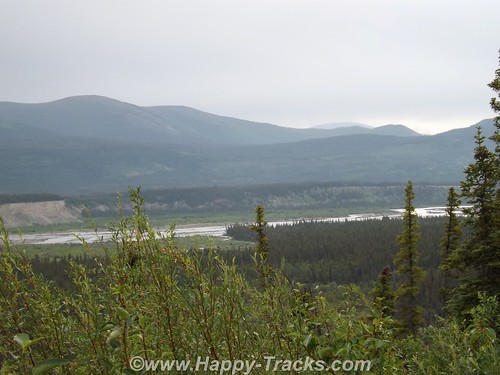
The next morning after we passed the bicyclists, we saw a moose on the side of the road but too late (we thought) to get his picture as we passed. I made a u-turn and headed back on the off chance that maybe we could get another glimpse. I think he was used to working with tourists as he waited for us and just posed waiting for me. We snapped off a few pics before he decided he’d had enough and moved off into the trees.

We started encountering more and more of the undulating pavement called frost heave. As we understand, the road is built on a base that includes permafrost which will thaw and melt under the roadway. It looks to be a full-time job to keep up with the roads although the major rework is limited somewhat to summer months.

This picture shows a research project designed to help deal with the frost heave by equalizing the temperatures of the road bed. As we neared the end of the this stretch of construction, we felt the telltale rumble of a flat tire.

We hooked the pump to it to get us to a better spot for changing since the leak seemed to be definite but slow. While we were letting it fill, some of the construction crew stopped and told us the next settlement was just around the curve and which shop did tire repairs. They also told us where to find the owner if he wasn’t in the shop when we got there. As it turned out, the leak was slow enough to let us make it to the shop where we found a nice flat piece of concrete to jack it up and dig out one of the spares. As it turned out, the tire was not repairable but we had a second spare to go the rest of the way (we hoped) with us.
The next major point of interest was the Canadian Customs station which was about 20 miles before the border and then the border itself. While we were expecting there to be some space between the Customs stations, we were a bit surprised that there was this much “unpatrolled” distance between the two.




The US Customs station was just a few hundred feet past the border. We had some of Mom’s pictures that we had hoped to re-create but the Customs Agent told us that this facility was new and that the Customs Station in the 1950s had been 90 miles up the road in Tok.
Another 3 miles north and we were back into the rain as we pulled into the Border City Lodge. Typical lodge along the highway but it seemed the shelves were nearly empty, but there was a special for lunch and we both had the navy bean and ham soup. Maybe its because it had been so long since we’d had it but it was great and served with a half sandwich. The lady working the diner section told us that they had changed management this year so inventory was down. They had some beautiful animal skins, including a black bear, mounted on the walls.
We continued north to Tok where the Customs station had once been. That site is now the State Police station. There is a very modern Visitors Center with information on much of Alaska for whichever direction you leave the crossroads town. There are several gas stations, restaurants and a pretty extensive gift shop.
There is also a large (but closed) motel at the main corner. It seems that this had until recently been a major stop for the cruise line tours. Weather frequently interfered with the tour stops and the cruise lines picked a different spot. This worked to our advantage indirectly as the restaurant at the Golden Bear where we stayed now had the chef from the cruise lines motel. We had the best Mexican dinner!
The Golden Bear also had a speaker each night, one of the Iditerod drivers who had placed just a couple of years before. That night they also had a tour bus stopping in so we skipped the meet and greet.

The bridge over the Tanana is in at least one of Mom’s and Dad’s pictures but we couldn’t find the exact spot where they took this picture, probably because the highway had been rerouted in its modernization but we did get some pictures nearby.



Twenty miles later, we were in Delta Junction at the intersection with the Richardson Highway. We had reached the end of the Alaska Highway! The spot is marked by another milepost similar to the one 1422 miles away in Dawson Creek.



The story of the Alaska Highway from its origins in 1942 as a means to get military support to the Alaska territory to today as primary transport link for tourists and commerce is a long one, almost as long as the highway itself. We decided to make the trip because Mom and Dad and my sisters, Bonnie and Faith had made that trip 60 some years ago pulling that Spartan trailer behind the Packard heading north and behind the Chevy pickup heading south. The highway doesn’t follow quite the same route, its all paved now but some of the places are basically unchanged.
You can see all of the pictures from this leg of the trip here.
We invite you to continue along with us and hope you enjoy the account!
Summer 2014: Alaska via the AlCan, Alberta
We crossed the border at Carway and proceeded to Lethbridge for the night. We still needed to convert US or obtain Canadian cash. That turned out to be relatively painless as we just used our own bank’s ATM card at the TD Bank ABM. We knew we would incur a service charge from one or both banks and that the conversion would be factored into what was removed from the account. Sounds complicated but it really was as simple as the ATM withdrawal at home. For those of us used to US currency, Canadian currency looks strange. It has a window of transparent film where you can see through it. Canadians have also abandoned the use of the penny. All our cash purchases were rounded to the nearest 5 cents. One dollar (loonie) and two dollars (toonie) are coins rather than bills.
If one were to map out a route from Lethbridge to the start of the AlCan Highway, your route would most likely take you to Calgary, then to Edmonton and then northwest along Route 43, a modern highway, to Grand Prairie and then to Dawson Creek and the beginning of the AlCan (generally now called the Alaska Highway). We chose instead to continue north from Edmonton to Athabasca, then west-ish to Grand Prairie because this would more closely follow the 1950s routing of the highway and its approach, as Route 43 didn’t exist.
From Lethbridge north past Edmonton, the highway itself was fairly modern divided 4 lane affair. It was of modern state highway standards generally. The route took us through farmland and around the perimeter of most towns.

We did take the opportunity to try out a Tim Horton’s for our morning break. We’d heard a lot about Tim Horton’s and wanted to try for ourselves. We decided their coffee was okay and their pastries were very good. To each his own, I suppose. Since returning home, we’ve heard a lot more about Tim Horton’s because of acquisition talks by Burger King.
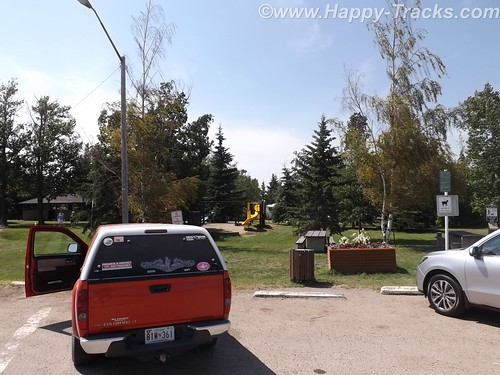
There was the occasional rest area such as this one in Bowden that incorporated the town park, a playground, a picnic area and camping facilities including showers in the restrooms. It was seasonally open and there was a petition to sign to keep the facility open. Apparently budget considerations at the Provincial level had the residents concerned.
We went around the edge of Calgary which appeared to be a modern city from our vantage point with mid- and highrise buildings rising up from the relatively flat prairie.

As we passed Edmonton, we passed through city traffic and turned north towards Athabasca. Athabasca is a small (population <3000 in 2011) town whose importance dates back to the days of the fur trade when it was known as Athabasca Landing and marked one end of the Athabasca-Edmonton trail which connected the waters of Athabasca River (flows north) and the North Saskatchewan River which flowed into Hudson's Bay. 
It lies along Highway 2 which connected the AlCan to points east. Eventually it was to be a railroad stop but the reality had it as a terminus where trains pulled in from the east and then pulled back out to the east. Trains to Athabasca had locomotives on both ends as there was no roundhouse or other turnaround point. Eventually the railroad stopped running to Athabasca and its economy was ruled by its crossroads location and tourism for the river.

Today its economy still depends on tourism but the proximity to the Athabasca tar sands oil fields are driving an economic boom. On the edge of town sit two new and chain hotels, a Super 8 and a Comfort Inn whose business is in providing lodging for the workers supporting the oil operations. The oil industry is probably also responsible for a resurgence of the tourism and the restoration of the old train station as a tourist center. We couldn’t find figures for the size of the transient/temporary population.

The Super 8 (while new and 3 stories tall) has adjacent construction which appears to be an expansion. The desk clerk was a younger blonde woman with an accent. In conversation, she revealed she was from Ecuador and that her brother worked in the Embassy in Washington DC so she was familiar with our home territory.
The economic boom has also fed other salaries as well. The local A&W had a Help Wanted sign advertising a starting salary of $14/hour.
The town grid may be large but the developed streets are numbered 47 through 57. As we came to see in many of the small (and larger) towns, flowers were in profuse bloom along the streets and hanging from the lamp posts.


We ate at the 49th Street Restaurant which had Greek food, seafood and more generic fare (quite tasty and reasonably priced). There were probably three other tables in use while we were there, one by what appeared and sounded to be Asian businessmen, possibly related to the oil exploration.

Across the street was the Athabasca United Church of Canada, a traditionally older church. We also found the Ukranian Orthodox Church of St. Peter and St. Paul. We were surprised at the density of churches (at least 10 in town) for its population.

Over the course of our trip, we would send out 37 postcards to our daughter, not counting other recipients. You do remember postcards, don’t you? So we set about to find appropriate stamps and a card. In a town this small, the post office should be easy, right? It was smack dab in the center of town. But our GPS labeled it as being on the opposite side of the street in either an empty lot or the boarded-up movie theater. We finally asked directions and were pointed to the modern brick building across the street. You know, the only one with a flag flying outside. We bought our stamps and were given the requisite Par Avion/Airmail stamps for international mail and then set out to find a card. We were referred to the dollar store –which had no cards but did have plastic hangers for our clothes drying experiment — the drug store which had greeting cards but no postcards and finally to the tourist center which did indeed have only one postcard of the centennial celebration in 2011 but it was free.

We mailed our postcard and headed out of town, headed west.

The highway is called the Northern Wood and Water Route. We passed through several small towns and also noted this industrial facility which we never really identified. We’re thinking it may be the Tolko OSB plant which makes construction products. More signs of a growing economy? The fields here and before we got to Athabasca were bright yellow and we think the crop was canola.
We stopped in Slave Lake for gas and lunch. At the gas station, we filled one of the 5 gallon cans we’d brought along in case we got stuck along the way. (We never used it.) The town is older and off the main road with signs pointed toward the lake, which is Little Slave Lake. The town had 5 or 6 motels and we ate at an A&W restaurant, something you don’t see much of in the States these days. Their root beer is as good as it ever was, I think. Our box of chicken came with French and English translations. It appeared to be a resort town and we never found the park at the lakefront.
We started noticing different road signs like “Important Intersection” and we met a truck with a “wide load” that appeared to be a two car garage coming at us. A lot of the signs were graphics instead of words, like a fisherman for the lake access or someone reading a book for the library or a water slide amusement park. One of my favorites (which took me a bit to figure out) was the two cars beside each other in a green circle to indicate a passing zone.
One of the little towns we pass through is Beaverlodge which has this huge statue of a Beaver which was built to mark the town name as well as pay tribute to the industrious beaver, which was the earliest distinctive symbol of Canada (per the sign posted next to the beaver.)

We came upon some one lane roads through construction, which seems to be a regular occurrence throughout our trip and during the summer months.

Eventually we cross into British Columbia and reach Dawson Creek, the southern and eastern end of the AlCan Highway — Mile 0. Note that it is now called the Alaska Highway officially but I will continue to use AlCan.
At Dawson Creek, we became aware of the smoke in the area. Forest fires were burning further south in British Columbia. We would see ash on the truck the next morning.

From a sign marking the 50th Anniversary of the Highway’s construction:
In the early hours of March 9, 1942, the first troop trains of the United States Army Corps of Engineers arrived in Dawson Creek to begin construction of the 2450 kilometre (1,523 mile) Alaska Highway. Overnight Dawson Creek was transformed from a small agricultural community of 500 into a bustling terminus for troops and supplies. At peak construction the population swelled to 10,000. Tent cities sprang up in farmers’ fields to help house the massive influx. The Northern Alberta Railway Station, the “end of steel”, became a centre of activity and sometimes, temporary home for thousands of military and civilian workers, may of who arrived with little knowledge of road building — or subzero temperatures.
During construction Dawson Creek served as a clearing house for supplies and equipment, as well as workers. In the spring of 1942 some 600 carloads of tractors, bulldozers, fuel and supplies arrived by rail from Edmonton for dispersal to construction camps along the route north.
Though the highway was completed in record time, it was not without its mishaps. One of the worst tragedies occurred in Dawson Creek in February 1943 when 60,000 cases of dynamite exploded in the centre of town, injuring many but miraculously, taking only five lives. The explosion leveled an entire city block and changed the face of Dawson Creek forever.
The modern city of Dawson Creek is rooted in those frenetic, exciting years of road construction. Though agriculture remains the driving economic force in the region, the transportation links forged through muckeg, ice and snow continue to play a major role.
The Mile 0 Post
The Traffic Circle located at the intersection of Alaska Avenue and 8th Street marks the designated Mile 0 of the Alaska Highway. A plain four-foot post once marked the site. In 1946, when this was hit by a car, a new Mile 0 Post was designed and moved to the centre of Dawson Creek where it stands today. The Mile 0 Cairn in Northern Alberta Railway Park was erected in the late 1950s to replace the original post that marked the “true” beginning of the highway north.
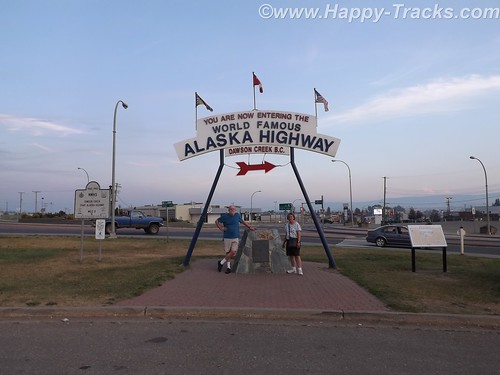
We took pictures of us by the cairn and talked to motorcyclists who were marking the occasion of their trip.
We also got a picture of the Milepost in the center of town, just as my mother did when they passed this way.
Tomorrow, we start on the AlCan.


You can see all of the pictures from this leg of the trip here.
We invite you to continue along with us and hope you enjoy the account!
Summer 2014: Alaska via the AlCan, Yellowstone National Park
Yellowstone National Park was established in 1872 by Act of Congress and signed by President Grant. It is widely thought to be the first national park in the world. The area was bypassed by the Lewis and Clark Expedition and exploration really started in the late 1860s. Initially, it was overseen by the US Army at Fort Yellowstone in the northern section of the park. Administration passed to the National Park Service following its establishment in 1917.

We left our cabin in Cody after breakfast and entered the park though the east entrance with plans to make a backward S and leave through the north entrance by day’s end.

On entering the park, we received our separate handout sheet advising against feeding the animals and telling us that wild animals were dangerous. It also cautioned us to stay in the car when animals were nearby. The road in took us around the shoreline of Yellowstone Lake and into Lake Village.

As we could first see the lake, we entered the area of the park where sulphur vents and you could smell it as soon as we entered the region. We stopped by the lake and took a few pictures then headed on towards Lake Village. On the way, there was a car stopped in the road for no apparent reason. As we got closer, we realize that they had stopped and gotten out of the car to take pictures of a bison in the field.

There was a pulloff nearby and we backed up to it and parked out of the road and took a picture of our own. We learned (and it would be reinforced throughout our trip) that when you see a car stopped, chances are someone has sighted a wild animal, even though the park literature reminds you frequently not to stop in the road.
We continued on to Lake Village where we would find a commercial area (gas, food, restaurants) as well as a visitor center. The ranger at the visitor center gave us the latest updates for expected eruptions at Old Faithful, one of our “must do” sights.

Shortly after we passed the West Thumb Information Station area and turned to continue on the Grand Loop Road, we were waved down by a young man who had been bicycling. His girlfriend had fallen off her bike and needed assistance. He said she was shaken up and we volunteered to call for help. Punching the OnStar button, we soon were in contact with their personnel who patched us through to emergency services in the park. While we were doing that, another truck stopped. Luckily, it was being driven by an off duty EMT who was able to assess her condition and was drafted to transport her and her bike over to the West Thumb first aid station. We informed the emergency services folks of the resolution and went on our way. While we were glad to be of assistance, we breathed a sigh of relief as we realized we would still be able to make the next eruption of Old Faithful if we got on our way.

There was a crowd of people there, both for the geyser show and for the lodge, restaurant and shopping area. We found our spot on the viewing deck and waited for the show. As the time drew closer, more people crowded into the area.
While we were waiting, we saw steam erupting from the other geysers in the area but still we waited for the most famous one. After several smaller spurts and steam, the big show came and we were suitably impressed.



It is truly amazing to watch Mother Earth in action. We had seen pictures and video but its nothing like seeing it in person. One thing that no one ever mentioned was the sound and the noise. Anyone who has ever worked in a steam plant (such as a nuclear submarine) has nightmares about the sound of high velocity steam escaping. Wow.
After the show, we went into the Old Faithful Lodge for lunch and to visit the shops.
We continued on to the Grand Prismatic Spring. The parking area there is small and was very crowded with folks waiting for others to leave before being able to park. The hot spring is the largest in the US and the third largest in the world. First records of it appear in a trapper’s notes from the 1830s. The colors near the edges are the result of microbes in a mat around the mineral-rich water. The center blue area is sterile due to the heat and its color derives from its depth and purity.



The microbial mat is extremely fragile and there are numerous warnings and prohibitions against walking on or otherwise disturbing the mat. While we were there, someone’s hat blew into the pool. Park personnel remove things like that with poles. On August 2, shortly after our visit, a tourist’s aerial drone mounted camera crashed into the pool. It’s still being investigated about how (or if) to remove it and the owner is facing charges.
Connecting the parking lot and the spring is a pathway that includes a walkway over an ice cold stream fed from the mountains. What a contrast.

That area is the Midway Geyser Basin and contains the dormant Excelsior Geyser as well.
We continued around our backwards S on the Grand Loop Road to visit Steamboat Geyser, the world’s tallest active geyser. It infrequently (and unpredictably) has a major eruption up to 300 feet in the air. It had been almost a year since its last major eruption. It has more frequent minor eruptions, including the day we were there.

But as we started back towards the truck, the skies let loose and it poured rain. We had umbrellas and windbreaker/rain jackets…back in the truck! So we half walked, half ran back.
We continued our ride towards the north entrance and saw the now telltale sign of cars stopped along the road. 
Animals? Sure enough, we saw this fox with something in its mouth coming along the road. We never were able to identify the prey in its mouth which appeared to be some sort of small mammal.
Traveling along, we again saw stopped cars, this time there were a number of them stopped in both lanes of the road. 

After a bit of sitting and waiting, we realized it was a black bear and three cubs working on crossing the road. Eventually, the adult bear crossed and the three cubs remained on the left side of the road. Then, to our absolute amazement, adults started getting out of their cars –with kids– and started walking up to where the bear and the cubs were on opposite sides of the road! Unbelievable! Finally some of the cars started moving by passing the parked and temporarily abandoned cars. When we were able to move on, the cubs remained on the left, the mother remained on the right and the humans kept on getting out and getting closer.
We stopped at Roosevelt Lodge and Cabins. This was the lodge used by President T. Roosevelt when he visited the area to hunt. There are also cabins, a restaurant and a small camping store there. We kept our comments about the bears and the tourists quiet as we weren’t sure how many of the patrons there had been part of the group. While paying for our purchases at the camping store, we got into a conversation with the clerk who was an older gentleman who had retired to this area from the New Bern area of NC.

From there, we visited a petrified redwood tree that is the same as present-day redwoods in California, giving testament to a very different Yellowstone in the distant past.
Our next wildlife sighting was another bison standing by himself in a grassy meadow. We found this one by ourselves without the aid of other cars.

We next arrived at the Mammoth Hot Springs resort and campground at the site of the old Fort Yellowstone. The public buildings are reclaimed barracks and dining facilities. The springs are a series of cascading pools on a hill of travertine.



There is a roadway which winds up the hill and lets you look down on the pools and the historic district. These pools, still more hot springs, really give you a different view than the Prismatic Spring. There was a dormant hot spring cone, Liberty Cap, too.


Leaving the Mammoth Hot Springs, you wind down and behind the historic district and onto a winding road out of the park. Just as we reached the boundary, a herd of antelope was crossing the road along the stream bed. Approaching dusk prevents us getting more pictures.
As we exited the park, we followed the Yellowstone River through the canyon to Livingston MT where we found a motel around 11:00. The motel was a Best Western and had a covered garage with a keypad lock for parking which seemed unusual and we never did really figure out why. At first, we suspected the winter weather but it seemed to be the only motel in the area with that feature. It also had an indoor heated pool which our room’s door faced. The humidity outside the room was a reminder of the hot springs we had seen that day.
This is a longer than usual post but it also was a longer than usual day for us. While we don’t advise spending only a day when you get to visit Yellowstone, we proved you could actually see much of it in a day.
You can see all of the pictures from this leg of the trip here.
We invite you to continue along with us and hope you enjoy the account!
Summer 2014: Alaska via the AlCan, Mt. Rushmore and Crazy Horse Memorial in SD
On Wednesday morning, we left Wall and made our way through the edges of the South Dakota Badlands toward Mt. Rushmore. We stayed on the interstate although the scenic loop through the Badlands was only 43 miles. We hadn’t yet fully acclimated to the amount of freedom our schedule provided. We were still able to see the Badlands though.
The giant granite carving of Mt. Rushmore is truly an American icon as a monument to freedom and greatness that are close to our hearts. Informally, the sculpture there has become an icon of the Great American Roadtrip Vacation which is somewhat fitting. It turns out that Mt. Rushmore shares more than geography with Wall Drug and the Corn Palace. Mt. Rushmore’s sculpture was intended to encourage tourism and get more people to visit that part of our great country. (By the way, 70 years later its still working as evidenced by our stop and the crowds that accompanied us that day. Annually, nearly 2 million people visit the monument.)
Admission to Mt. Rushmore is free but there is a charge for parking in the multi-level parking structure. Your parking fee is a one-time payment valid for the entire calendar year for that vehicle though.
When initially conceived, the sculpture included Lewis & Clark; Bill Cody and Red Cloud, a Sioux Chief representing heroes of the west. To increase its appeal, a national focus was determined to include the four Presidents we see there today. Doane Robinson, a South Dakota historian, is credited with being the initial champion of the concept.
There are varying (but similar) stories on why each was chosen
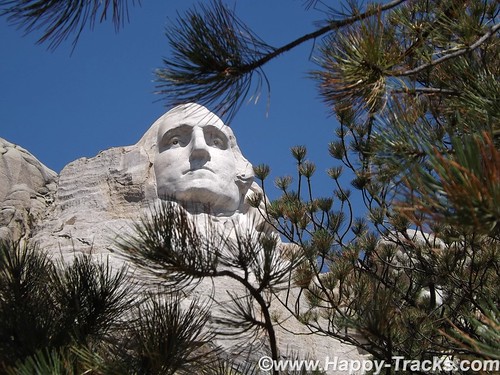
Washington: Birth of a nation and the struggle for independence
Jefferson: Expansion of a nation through the Louisiana Purchase and the belief of a government by the people

Lincoln: Preservation of the Union and Equality and Permanence

Roosevelt: Economic development of the USA, world prominence or the forward thinking of a National Parks system.
There was some thought of expanding the sculpture in 1937 to include Susan B. Anthony but the legislation precluded expansion, or scope creep. The original plans included sculpting from the waist up but construction stopped as it it is today in 1941. We also ran across at least one reference that Calvin Coolidge declared that the four chosen had to be party-balanced.
With all that background out of the way, I want to make sure to pass along that it is truly magnificent and breathtaking.

Beginning with the roadway in, the scenery is fantastic and there are ample opportunities to view the surrounding landscapes from various locations.

Once you’ve parked, you enter the National Monument by passing the gift shops, information booths, exhibits and eateries. Leaving there, you proceed along a majestic walkway adorned with flags from every state leading towards an amphitheater that allows you to just sit and stare or contemplate.

From there, you can walk along a path (handicap accessible) towards the base of the monument. Along this path, you can see a more natural surrounding and eventually reach a display that includes some teepee structures and an exhibit of a small Native American camp with music and a Ranger-provided talk.
From that point, you can look up at George Washington’s chin and proceed further along a trail in front of the base. I’m not certain of the official rating but that part of the trail, while still relatively easy walking seemed to not be accessible to some with handicaps.

This part of the trail seemed to provide a spot where you could view each President individually.
As the boardwalked trail becomes steeper, you eventually wind your way down to the artist’s studio where there are several displays including mockups of the initial sculpture. Outside there is an old generator and compressor setup that was used in the carving.

Surprising to us, there is a mockup of a Hall of Records, an archival room for documents relating to the construction of the monument. While not initially included, it has eventually been built and really exists behind President Lincoln’s head.

We climbed the uneven and steep (but solid) stone stairway back up to the entrance plaza were we lunched on bison burgers before checking the gift shop for postcards and continuing on our way to our next stop.

Just 16 miles away, on the other side of Harney Peak in the Black Hills National Forest is a memorial in progress, the pink-granite monument to Crazy Horse. The Crazy Horse monument is privately owned and financed and has refused government funding.
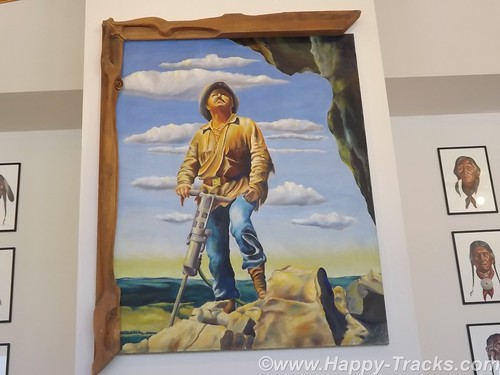
The Crazy Horse monument’s reluctant sculptor is Korczak Ziolkowski and his descendants. Ziolkowski won a prize in 1939 and was invited by Chief Henry Standing Bear to create a tribute to the North American Indians. Ziolkowski initially declined. Chief Standing Bear said, “My fellow chiefs and I would like the white man to know the red man has great heroes too.”
There was some disagreement about who the model for the sculpture should be and Crazy Horse was eventually chosen as he had a reputation for fairness and a dedication that shunned the limelight.

Ziolkowski had worked with Borglum on the final stages of Mt. Rushmore for a time. Conflicting stories appear as to whether he left because the work was done or because of a falling out. At any rate, in 1947, Ziolkowski had been convinced and returned to begin the work. The first blast was in June 1948. As he was working with limited funds, he was also using used equipment and with limited funding, he was often working by himself. He would tell stories of starting the compressor for the drills and beginning the long arduous ladder climb and hear the compressor chug to a halt before he had reached the top and was able to start working, necessitating the long climb down the mountain to restart the equipment and cimb back up.
According to our tour guide, Ziolkowski would work while he had funds and then would stop and do other things, including cutting timber from the property to sell. He also managed to buy up parcels of surrounding land and sometimes trade with the NPS to allow them to build contiguous parcels around Rushmore while he gathered contiguous parcels around the Crazy Horse Memorial.
This is the largest in-progress stone sculpture in the world. By way of comparison, the four Presidents’ sculpted heads (at 60 feet each) could all fit inside the horse’s head.

Mr. Ziolkowski knew the sculpture could not be completed in his lifetime but he took on the project anyway. To believe in a vision that you know you will not see completed and to sacrifice to make it happen is a strong story, especially in this day of instant gratification. He married in 1950 and they had 10 children, six of whom remain involved in the foundation and the sculpture today. He died in 1982. His wife, Ruth, ran the foundation until her death in May 2014.
When asked, Mrs. Z declined to provide an estimate of the expected cost of the monument, saying only that she expected the funds invested in the first 50 years was likely less than the cost remaining. She also expected that the timeline would still stretch for decades.
The Ziolkowski’s started a foundation which includes the museums and a scholarship fund, primarily for Native American students attending schools in South Dakota.
The annual visitation for the uncompleted monument is over 1 million and the grounds include a museum of Native American life as well as the sculptor’s home. Additionally, the site includes a shop where Native crafters display and sell their wares.

The first definable feature, the rider’s face, 26.67 meters (87ft 6in) high, was completed in 1998, in time for the 50th anniversary of the very first blast. Work subsequently began on the next phase – the horse’s head, 66.75 meters high. Although there is still no estimated completion date, Ruth never lost her faith that her husband’s vision would eventually be realized; she said her wish was to “live more years than possible because I would love to see it finished”.

Crazy Horse, who was one of the leading figures in the Native American defeat of General Custer at the battle of Little Bighorn in 1876, pointing towards his prairie heartland. “My lands are where my dead lie buried.”

We spent the night in Custer SD.

You can see all of the pictures from this leg of the trip here.
We invite you to continue along with us and hope you enjoy the account!
Summer 2014: Alaska via the AlCan Begins
In the early 50s, Mom and Dad went up and down the AlCan twice with my sisters (before I was born). In those days, mobile homes were still pretty mobile. On the second trip, they pulled their Spartan mobile home behind the Packard on the way up and behind a Chevy pickup on the way down.

Traveling along with them on the way to Alaska were 4 other families, also pulling their own mobile homes. The adults in those five families were lifelong friends, in part due to their shared adventures. To the best of my knowledge, two of the wives are still alive. I know my Mom stayed in touch with those folks until her death in 2007.
On that second trip, Mom had an Argus C3 that she bought with money earned from baking pies which Dad sold at work. I heard about their trip my entire life and saw the pictures and had this trip on my “bucket list” before I knew what a bucket list was. You can find quite a few of Mom’s pictures here.
On Sunday, July 6, 2014, Betty, my wife and I loaded up our Chevy Colorado and left Maryland with plans to reach Alaska and to retrace some of their route.
Much of the 1950s AlCan highway no longer exists. The AlCan was hastily constructed in 1942 as a means to reach from the contiguous United States to the Alaska territory as part of the effort to defend the territory against the Japanese in World War II and also to enable the transport of US warplanes to Russia, our allies in WWII.
Our 2014 trip included trying to re-trace part of their route and also to visit some places we’d not seen before. Our trip included time in National and state parks as well as kitschy tourist destinations along the way.
 Our trip was taken in a Chevy Colorado crew cab pickup truck. There was no trailer but we did have a shell on the back and had taken the rear seat out to accommodate a 43 quart refrigerator/freezer that ran off of the 12 VDC accessory plug along with a spare battery. We packed a small bag with 3 or 4 outfits of shorts and t-shirts, a larger bag with several changes of warmer clotes and a loose bag with our winter coats, gloves and boots. We packed some basic foods, a camp stove, some cheese sticks and trail mix. We also had 2 spare tires, a container with an extra 5 gallons of gasoline and my toolbox and recovery equipment and a first aid kit and fire extinguisher. Electronics included our two cell phones, the truck’s OnStar setup, a laptop PC, a digital Fuji camera, a CB radio, a Ham 2M handheld, and a device called a SPOT tracker for emergency communications and routine checking in via satellite. See Find Me Spot
Our trip was taken in a Chevy Colorado crew cab pickup truck. There was no trailer but we did have a shell on the back and had taken the rear seat out to accommodate a 43 quart refrigerator/freezer that ran off of the 12 VDC accessory plug along with a spare battery. We packed a small bag with 3 or 4 outfits of shorts and t-shirts, a larger bag with several changes of warmer clotes and a loose bag with our winter coats, gloves and boots. We packed some basic foods, a camp stove, some cheese sticks and trail mix. We also had 2 spare tires, a container with an extra 5 gallons of gasoline and my toolbox and recovery equipment and a first aid kit and fire extinguisher. Electronics included our two cell phones, the truck’s OnStar setup, a laptop PC, a digital Fuji camera, a CB radio, a Ham 2M handheld, and a device called a SPOT tracker for emergency communications and routine checking in via satellite. See Find Me Spot
Along the way, we did laundry using a 5 gallon plastic bucket (originally a deli-sized container of pickle chips) with a gamma — leak resistant — sealed lid to wash clothes. We would add the dirty clothes, a little detergent and about 4 gallons of water and let it ride in the back of the truck to agitate. At night, we would take the bucket inside with us and rinse the clothes then hang them on plastic hangers from a ratchet strap strung between the two rear seat assist handles in the truck. Got a few odd looks at border crossings but it worked out well.


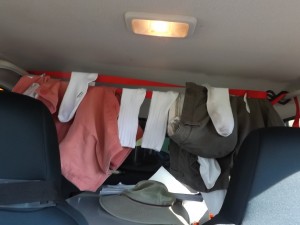 By way of preparation, we had to prepare to leave the house for 6 weeks to 2 months (our itenerary was fluid). This meant paying the routine bills (utilities, storage rental, newspaper, cellphones) in advance as we don’t use online banking or bill paying; arranging for the grass to be cut, the mail held and the newspaper delivery stopped. We also notified a few close, strategically-located neighbors of our coming absence and expected comings and goings around the house. We also attempted (unsuccessfully) to arrange for some Canadian cash through our bank and made certain our credit card company was aware we would be on the road and expecting to use the card in places and with frequency outside our normal usage patterns.
By way of preparation, we had to prepare to leave the house for 6 weeks to 2 months (our itenerary was fluid). This meant paying the routine bills (utilities, storage rental, newspaper, cellphones) in advance as we don’t use online banking or bill paying; arranging for the grass to be cut, the mail held and the newspaper delivery stopped. We also notified a few close, strategically-located neighbors of our coming absence and expected comings and goings around the house. We also attempted (unsuccessfully) to arrange for some Canadian cash through our bank and made certain our credit card company was aware we would be on the road and expecting to use the card in places and with frequency outside our normal usage patterns.
The Washington Post didn’t manage to process the vacation hold on the newspaper but our neighbor intercepted most of the unplanned deliveries. Bank of America couldn’t process our request for Canadian cash in sufficient time to get our cash before we left but a TD Bank in Alberta accepted our ATM (ABM for you Canadians) card to dispense the desired currency. One of the lamps on a timer at home decided to blow the bulb sometime (1 day? 6 weeks?) before we returned. The credit card was refused once on our trip but we think that may have been input error by the hotel rather than an issue with the CC company. Of all the logistics to be arranged, these were minor glitches that had minimal impact in the grand scheme of things.
A few statistics for your consideration.
Total driven miles: 11,704
Gasoline consumption: 556 US gallons at an average cost of $4.20 per gallon.
40 hotel nights and one on the ferry between Haines AK and Prince Rupert BC
14 states traveled and 3 Canadian provinces
1 flat tire and 1 cracked windshield
Most days, we posted up to 10 pictures on Facebook which some of you have already seen. This blog will share our story and give you a chronological account of our trip along with some more pictures and the story behind some of those pictures you’ve already seen.
We invite you to come along with us and hope you enjoy the account!
Desert Expedition III: Nevada – Post 6 – Goldfield, Tonopah, Manhattan, Belmont and Pine Creek Campground
Alas, Monday morning comes and folks have places to be, loved ones to see and commitments to be met. We bid adieu to the others but Gary, Ace and I stayed together with plans to see some more and hoped to make it to Great Basin National Park.
We left and headed back to Tonopah for re-provisioning. Along the way, we passed through Goldfield NV but didn’t stop. Goldfield is more recent town which grew from the discovery of gold in 1902. Mining until 1940, over $86 million was extracted. Much of the town was destroyed by a fire in 1923, although several buildings survived and remain today, notably the Goldfield Hotel, the Consolidated Mines Building (the communications center of the town until 1963), and the schoolhouse. Gold exploration still continues in and around the town today. The hotel is not currently open and some accounts describe it as haunted. There is an ongoing effort to restore many of the old buildings and build the tourist trade. You can find out more at Ghost Town Operations.com website.
Teddy Roosevelt visited Goldfield and there is a story that Wyatt Earpp came to Goldfield after the Gunfight at the OK Corral but there is little to support that. It is confirmed that his brother, Virgil, worked, lived and died in Goldfield although he is buried in Portland, Oregon.



The school is the building in the right of the picture above.

RV parking behind the casino in Tonopah.
Continuing along to Manhattan, we find another town’s mainstreet which has obvously seen better days.

This church, which sets on a hill above Manhattan’s main street was orignially constructed in Belmont.




We stopped for lunch outside of town and then went on to Belmont, NV.


Although closed this day, there are still accommodations to be had at the old Combination Miining Co. building, including the Old Boots Saloon.

Remains of the bank.
Belmont is the site of a spring used by the Shoshone. In 1865, the discovery of silver ore led to a boom that eventually led to the buildup of a commercial center including schools, a post office, a newspaper and eventually becoming the county seat of Nye County from 1867 to 1905.
Belmont was known as a rowdy town with saloons, a red light district and various ethnic neighborhoods. Roughly $4 million was extracted from the shallow ore.

Courthouse from the days of County seat.
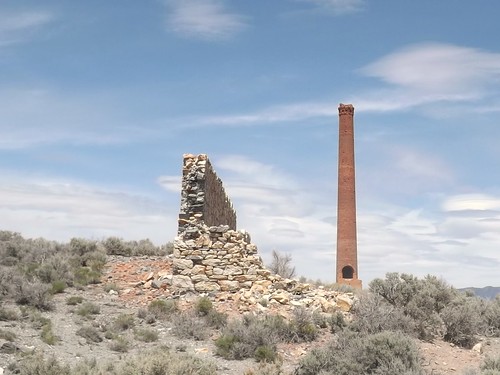
Remnants of the Combination Mining Mill in East Belmont.

We traveled further north and found a spot for the night in the Pine Creek Campground in the Toiyabe National Forest.


The weather forecasts were calling for cold, possible rain/sleet and this spot seemed fairly sheltered.
More photos from this leg of the trip.
If you’d like to be notified of new posts, use the Subscribe button in the upper left and provide your email. Your email will not be used for any other purpose!
January 27: Old Friends Touring DC: Navy Memorial and National Portrait Gallery
A rare treat for the Old Friends weekend, we were able to tour on Sunday as well. Today included breakfast, church and then a trip to downtown DC to visit the Navy Memorial (site of the Lone Sailor) and the National Portrait Gallery.
Our first stop after finding parking (which was free on the street where we were since it was Sunday), was a walking trip through Judiciary Square where we found these two gents deeply absorbed in an impromptu chess game. They didn’t include a timer. Russ pointed out that the board was also set wrong, not something to be noticed by the casual observer.

Our primary stop was just around the corner on Pennsylvania Avenue at the Navy Memorial. Best known for the statue of the Lone Sailor out front, there are exhibits and a theater inside. 2012 was celebrated as the Year of the Chief.
 This centerpiece hangs in the center of the spiral staircase leading down to the main exhibit floor. This one is beautifully made of wood with the woodgrain showing as the gold color with painted silver for the shield. This is a replica of the traditional Chief Petty Officer’s collar device, the fouled anchor.
This centerpiece hangs in the center of the spiral staircase leading down to the main exhibit floor. This one is beautifully made of wood with the woodgrain showing as the gold color with painted silver for the shield. This is a replica of the traditional Chief Petty Officer’s collar device, the fouled anchor.

I’ll take a moment to apologize here for the quality of some of the pictures that follow. The lighting showed a glare on several of the displays. Normally, I’d reject those pictures but I believe the Navy Memorial needs to be shared a bit more and I’ll compromise the picture quality to give you a better idea what’s there.

Multiple memorial plaques provided in exchange for donations. There were a number of displays similar to this one.

The Senior Enlisted Sailor in the Navy is the Master Chief Petty Officer of the Navy (MCPON). This display pays tribute to those who have served in this capacity. Of the 13 men who have served as MCPON, three were submarine-qualified (James Herdt 1998-2002; Terry Scott 2002-2006; and Rick West 2008-2012)


 The Navy Memorial maintains a log that allows sailors or their families to enter pertinent data about the sailor as part of the memorial. Their goal is to include all Navy Sea Service Vets. Father Steve was looking things over but decided to complete the entry back at Chateau Pierre.
The Navy Memorial maintains a log that allows sailors or their families to enter pertinent data about the sailor as part of the memorial. Their goal is to include all Navy Sea Service Vets. Father Steve was looking things over but decided to complete the entry back at Chateau Pierre.

The Memorial includes a library of books (fiction and non-fiction) about the Navy and its sailors and also by some of the sailors.

The display included portraits of Presidents who had served in the Navy. This one is John Kennedy. Also included were Lyndon Johnson, Richard Nixon, Gerald Ford, Jimmy Carter and George H.W. Bush.

The Navy Memorial maintains a log of sea service veterans. This poster reminds us that sea service veterans are all around us and asks to help. Visit their website at www.NavyMemorial.org
 There are a number of scale models of Navy ships on display.
There are a number of scale models of Navy ships on display.
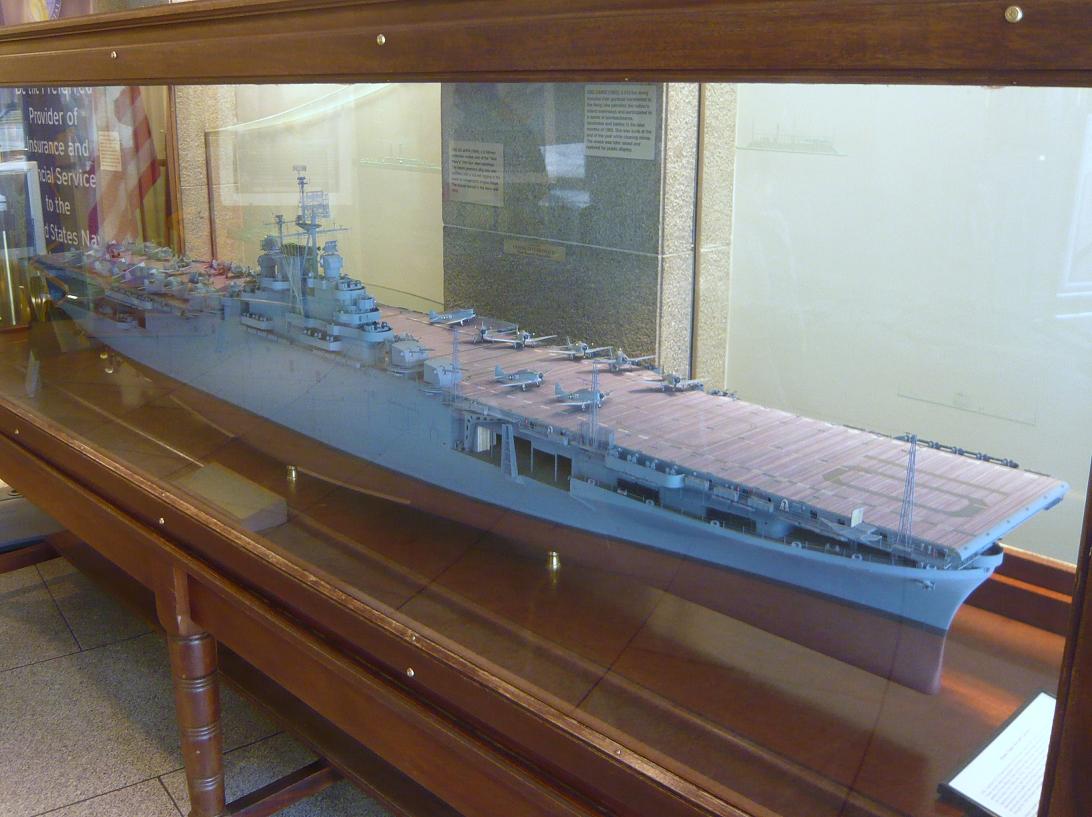

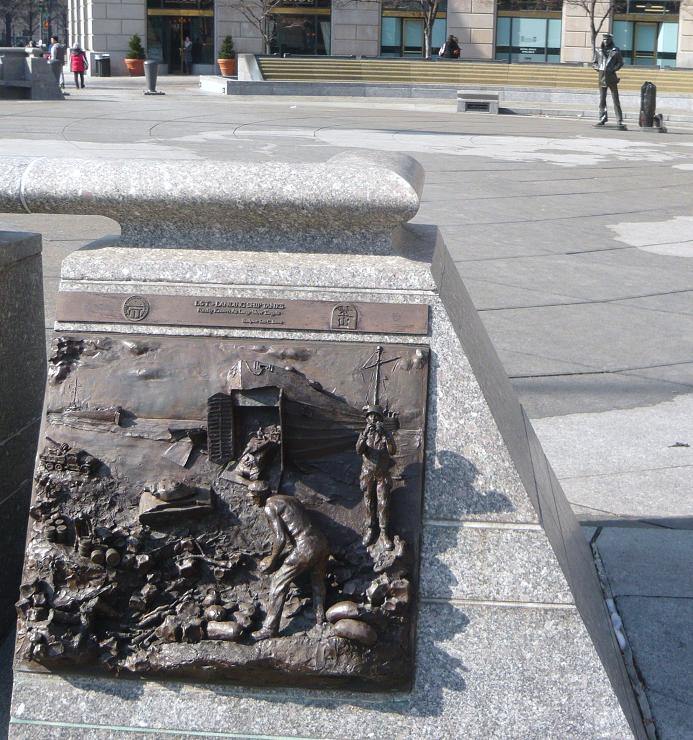
After visiting the Navy Memorial we headed over to visit the National Portrait Gallery. The National Portrait Gallery is part of the Smithsonian Institution and is dedicated to the display of portraits of persons who have made significant contributions to American history and culture. There is an extensive display of Presidential portraiture including a wire sculpture of President George H.W. Bush pitching horseshoes. The American Art Museum (which shares the building) included exhibits displaying the national parks and other persons in our history. There was an exhibit depicting Amelia Earhart and artifacts from the US Patent Office.
We highly recommend that you take the time to visit. While you’re there, allow time to take in the atrium in the center courtyard shown in the pictures below.

The water in this picture is no more than a quarter to half inch deep. Although it appears to be much deeper.
We chose to grab lunch in the atrium. There were a number of folks who seemed to be just enjoying the opportunity to relax and read or study in the pleasant temperatures and the sunshine coming through the glass roof. It sure beat the cold outside.
 After we left the Portrait Gallery, it was time for Russ to hit the road south while Father Steve, Betty and Keith headed back to Germantown.
After we left the Portrait Gallery, it was time for Russ to hit the road south while Father Steve, Betty and Keith headed back to Germantown.
Father Steve left on Monday via BWI where he experienced his unusual luck at finding delayed flights but arrived safely back at home, albeit a bit later than planned.
It was another great weekend with great friends, exploring the sights right here in our own backyard.
January 25: Old Friends Touring Monticello
Steve and Russ were two of Keith’s roommates when we were at the Navy’s training facility in New York. Although our paths diverged quite a bit afterwards, it was an intense time in our lives and the friendship that really got its roots there has continued and deepened through the years. At least once per year, we try to get together and visit with each other and to play tourist somewhere. For point of reference, Betty and Keith met while Steve, Russ and he were roommates.
On January 24, the website for Thomas Jefferson’s home in the hills near Charlottesville VA indicated that they had closed early due to the inclement weather but to check back for the schedule for the next  day. At sometime after 9:00 am on Friday, January 25 the website indicated they would be open normal hours so we loaded up with hopes of seeing Monticello and maybe even Monroe’s Ash Lawn and Madison’s Montpelier. The forecast was calling for the possibility of light snow in the early evening.
day. At sometime after 9:00 am on Friday, January 25 the website indicated they would be open normal hours so we loaded up with hopes of seeing Monticello and maybe even Monroe’s Ash Lawn and Madison’s Montpelier. The forecast was calling for the possibility of light snow in the early evening.
Not in any particular hurry to get there, we meandered a bit and considered getting lunch on the way but decided to wait until after our tour and pulled into the nearly deserted parking lot about 1:00. It appears the flurries and cold had discouraged many less hearty souls from the hilltop this afternoon. We went inside the cluster of buildings and bought our tickets for the 1:30 tour. After we purchased our tickets, we were told that would be the last tour this day as they would be closing early today because of the weather. When I had last toured Monticello (a time best measured as a couple of decades rather than a specific number of years), tickets were purchased at booths similar to those seen at a fair rather than the complex of steel and cedar with brick walkways.  Since our tour was departing soon, we decided to skip past the gift shop and theater
Since our tour was departing soon, we decided to skip past the gift shop and theater 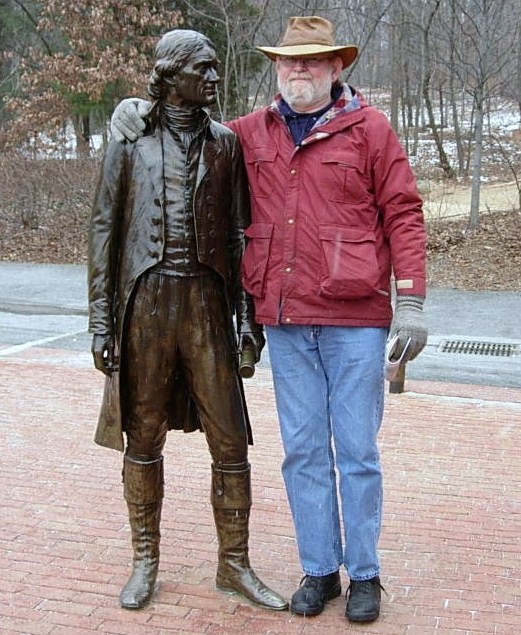
 but went into the museum to await the shuttle. The museum exhibit was themed more around the lives and times of the others living at Monticello, including the slaves of his era and later occupants. Outside the museum was a life-sized bronze statue of our third President and we all took the time to speak with him one-on-one.
but went into the museum to await the shuttle. The museum exhibit was themed more around the lives and times of the others living at Monticello, including the slaves of his era and later occupants. Outside the museum was a life-sized bronze statue of our third President and we all took the time to speak with him one-on-one.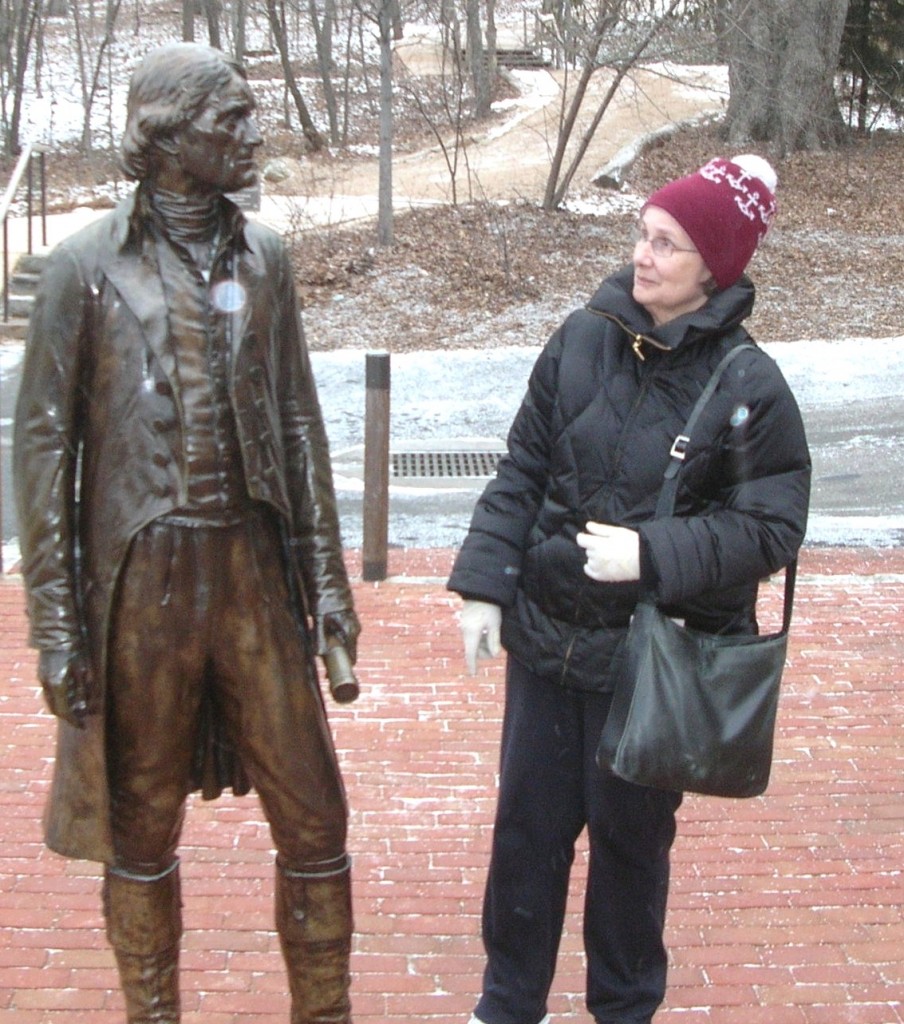
 We boarded the bus and Jefferson watched us head up the hill. He’d be there when we returned.
We boarded the bus and Jefferson watched us head up the hill. He’d be there when we returned.

We rode in the shuttle bus up to the main house and you could feel it getting colder and the snow flurries came more frequently.


“Y’all take your time looking around out there. We’re waiting on another bus but I’m closing this door.”
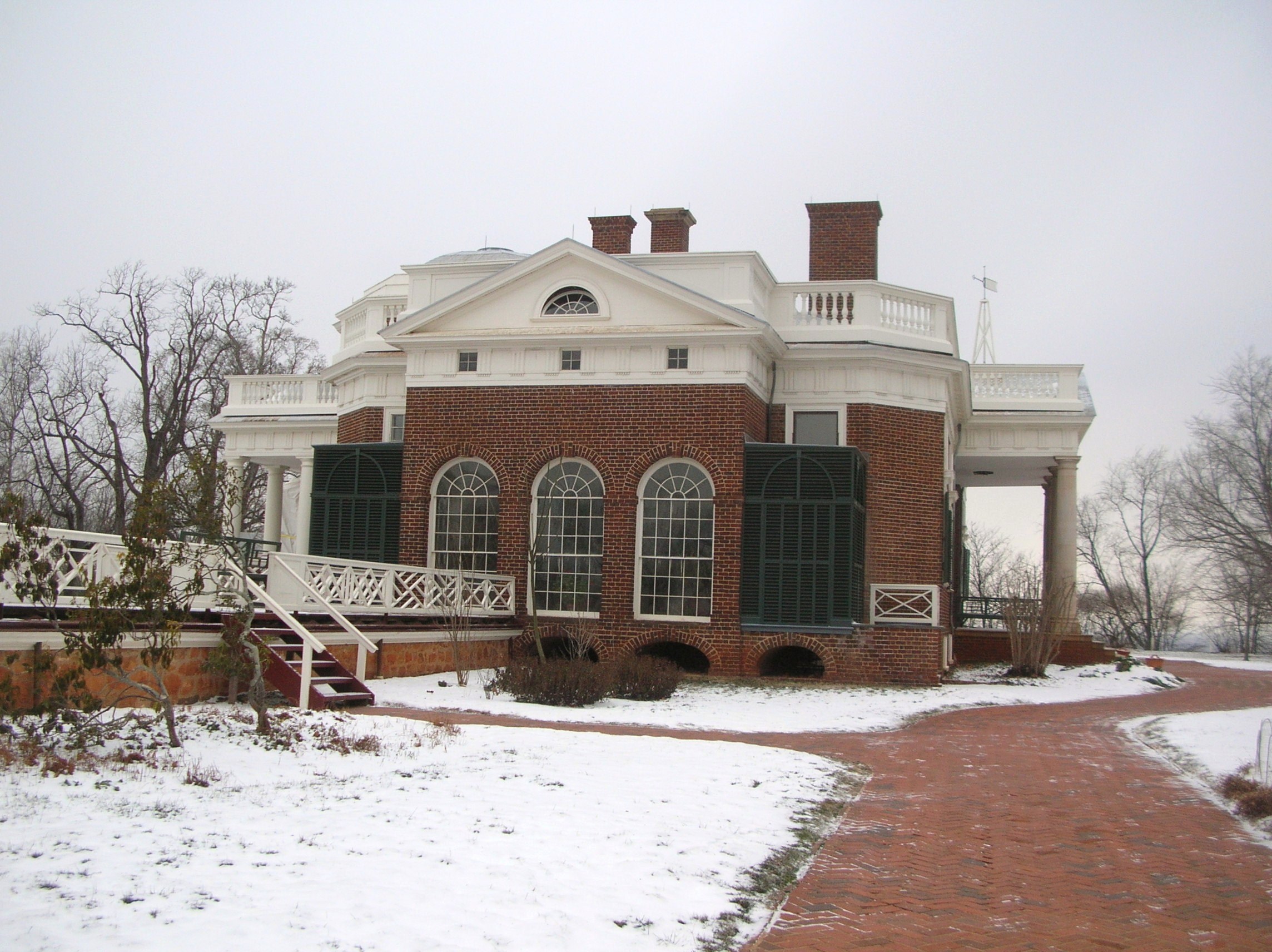
Jefferson’s library and personal quarters from the outside. The openings along the ground under the floor level allowed for warming fires to support the plants he grew.

Guest rooms occupied the rooms to the left in this picture and a tea room was to the right (rear). While Jefferson was ahead of his time in many regards, the accessible ramp is a more recent addition.
Our tour began on the first floor inside but the cameras had to be put away there due to copyright and ownership issues on some of the loaned display items. I suggest you visit the website here where more detailed discussions and pictures can be found.
The first room we visited was the main entry which included a view of the large one-week clock which Jefferson had built as well as artifacts from the Lewis and Clark Expedition into the Louisiana Purchase.
We moved into the family’s quarters seeing Jefferson’s library and hothouse which was heated in part by fires under the brick floor. We curved across the backside of the house and into the dining area with bright paint which seemed a cross between sunflowers and marigolds. Continuing around to the opposite front corner of the house, we viewed a guestroom and then moved down a narrow stairway to what would be service areas of the house, generally used by the servants and working folks rather than house guests.

This bottle-sized dumb waiter allowed sending wine directly from the wine cellar to the butler’s pantry off the dining room.
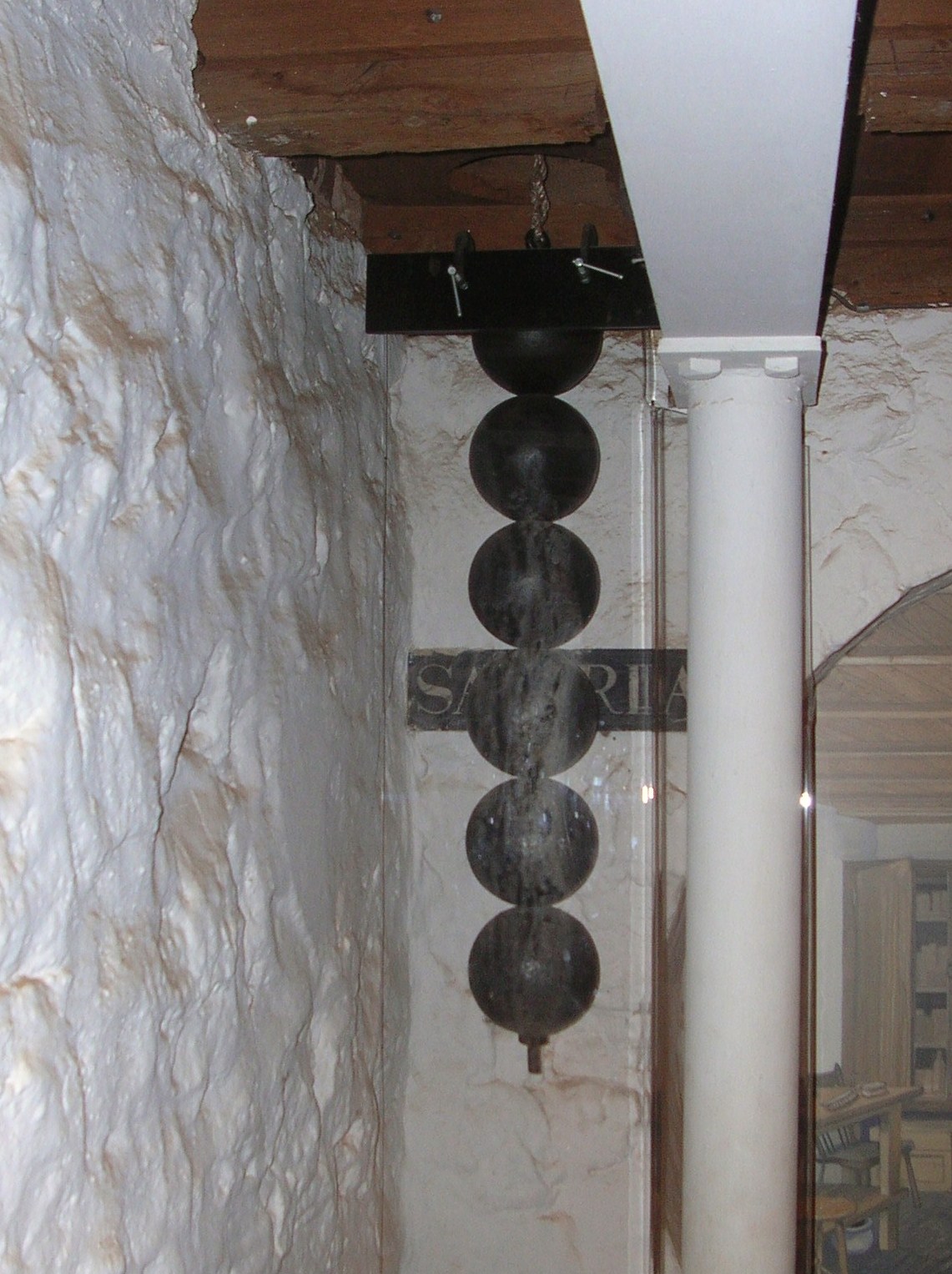
The 7 day clock upstairs is operated by these weights but the length is too much to be fully contained on one floor so the end of the weights goes into the cellar.

One of the cisterns. Because of periodic shortages of water, Mr. Jefferson installed 4 at strategic locations to catch rainwater from the house and walkways. Each of the four potentially held 3,800 gallons.

The more famous views of the house were actually the back. The white sheeting covering the columns is to protect renovation/restoration work in progress.

The fish pond is covered in ice. Fish caught in neighboring streams were kept alive until needed for the table.

The Garden Pavilion, favored by Jefferson as a quiet and peaceful place to read in the cool of the evening, was toppled by several windstorms following his death and was restored in 1984.

The south pavilion was called the “outchamber” by Jefferson. Thomas and Martha originally lived in this. The lower story was at first a kitchen until it was later converted to a laundry (1808). In about 1818, the laundry was moved to the North Pavilion as it was closer to a natural spring.

Under the walkway leading to the South Pavilion were several rooms which included a dairy (where milk was stored and butter made) and quarters for the enslaved workers who worked in and around the house.


Our tour guide graciously led us to the back of the house and invited us to look around but told us the last shuttle down the hill would be leaving soon. On the way down the hill back out to the visitors center, we were given a brief stop by the Jefferson family graveyard. 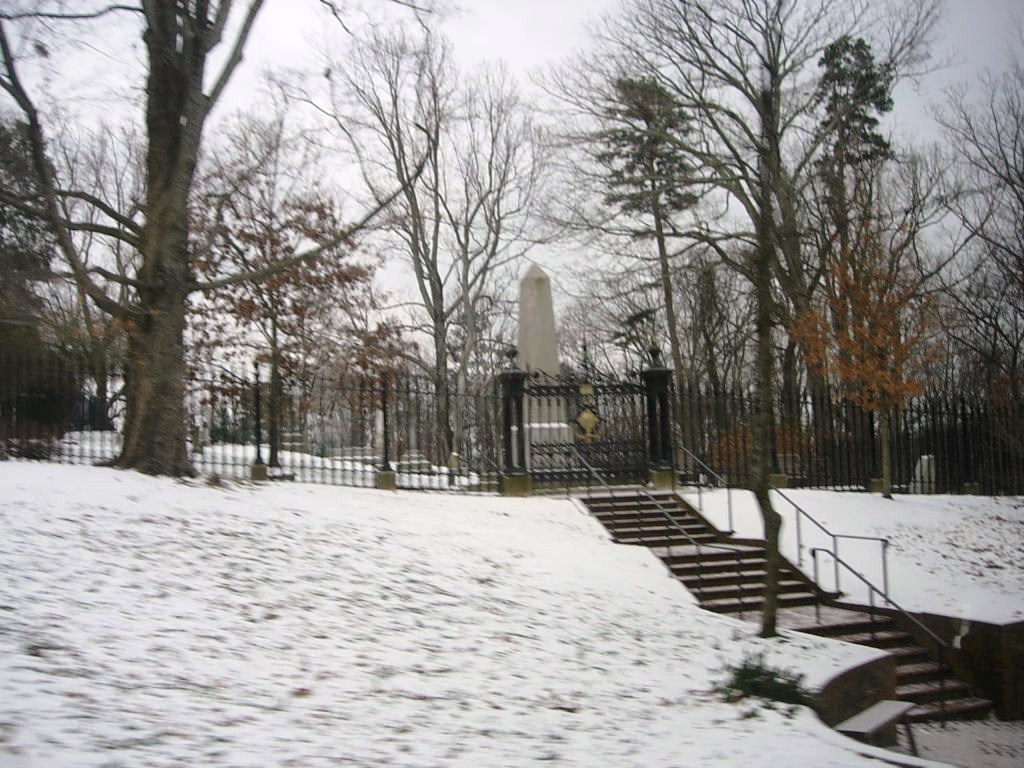
When we reached the visitors’ center, everything was locked up so no gift shop or looking around a bit further. It was back to the car to move along so they could close the gates.
In fairness to the folks at Monticello, we need to relate a bit more of the story. Yes, their website had said they would be open regular hours and the forecast was for slippery roads coming down off the hill but that was the same forecast they had when they announced they would be open all day. No one was rude but you could sense that the folks who worked there were concerned about getting safely home and we were what stood between them and being on their way. When we got home, we sent an email expressing a concern that the daily update of the website could stand a reevaluation of policy. They agreed and said they would be looking into that. They also sent us a set of tickets to be used for another day and a nice book from their gift shop. It’s often said that the true measure of customer service and graciousness is how you handle an issue, rather than a perfect record of never having an issue. They handled the recovery well.
After we left Monticello, we drove over to see nearby Ash Lawn, the estate of President John Monroe, owned and operated by his alma mater, the College of William and Mary. Alas, they were also closed due to the weather but we did manage to get a couple of pictures.

 We’ll have to save Ash Lawn for another day. Perhaps an earlier start will get us to Montpelier as well.
We’ll have to save Ash Lawn for another day. Perhaps an earlier start will get us to Montpelier as well.
And so we headed for home but we had skipped lunch and were all getting a bit hungry. In the course of seeking a restaurant that suited all, it became known that Father Steve HAD NEVER EATEN AT A WAFFLE HOUSE!!! So we remedied that.
 After food, it really was back to the house with a stop at Wawa (somewhere else Steve had never been).
After food, it really was back to the house with a stop at Wawa (somewhere else Steve had never been).
The Uno Championshp Series continued well into the night!













